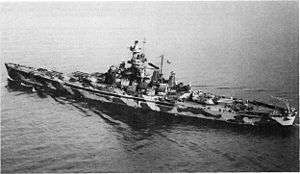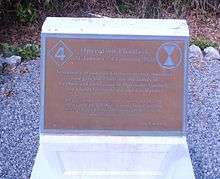Operation Flintlock (World War II)
Operation Flintlock was the campaign against the Marshall Islands in the Pacific campaign of World War II, from January to February 1944. The operation involved the invasions of Kwajalein and Eniwetok atolls. This attack sank a large number of Japanese ships and "Operation Hailstone" stripped the air base at Truk of its offensive potential. With Truk neutralized, it could be bypassed, forgoing a costly invasion. Executed on 31 January 1944, Kwajalein fell on 7 February after stiff Japanese resistance.
USS Alabama

The USS Alabama participated in "Operation Flintlock". The Alabama reached Funafuti, the Ellice Islands, on 21 January 1944, and there she rejoined the Fast Carrier Task Forces. She was assigned to Task Group 58.2, which was centered on the carrier Essex and light carriers.[1] The Alabama left the Ellice Islands on 25 January to help carry out the wresting of selected members of the Marshall Islands, such as Kwajalein Atoll and Eniewetok Atoll, from the Japanese. Alabama, South Dakota, and North Carolina bombarded Roi Islet on 29 January and Namur Islet on 30 January. She fired 330 rounds of 16 inches (406 mm) shells and 1,562 rounds of 5 inches (127 mm) ammunition toward Japanese targets, destroying planes, airfield facilities, blockhouses, other buildings, and artillery emplacements. Over the following days of this campaign, Alabama patrolled the area north of Kwajalein. On 12 February, Alabama sortied out with the aircraft carrier Bunker Hill's Task Group, and many other members of the Fast Carrier Task Force to launch very major carrier air attacks on the Japanese installations, aircraft, and shipping at the major Japanese Central Pacific base of Truk Atoll. This large series of air attacks, flown on 16 and 17 February, caused heavy damage to all of the Japanese airfields, and other installations, and the enemy shipping that had remained there. Very little of the Imperial Japanese Navy fleet, which had used Truk as a major forward base for years, remained there, since it had already departed northwards to safer waters.[1]
USS North Carolina
_during_Marshall_islands_campaign%2C_25_January_1944.jpg)
During the assault and capture of the Marshall Islands, USS North Carolina illustrated the classic battleship functions of World War II. She screened carriers from air attack in pre-invasion strikes as well as during close air support of troops ashore, beginning with the initial strikes on Kwajalein on 29 January. She fired on targets at Namur and Roi, where she sank a cargo ship in the lagoon.
The battlewagon then protected carriers in the massive air strike on Truk, the Japanese fleet base in the Carolines, where 39 large ships were left sunk, burning, or uselessly beached, and 211 planes were destroyed, another 104 severely damaged. Next she fought off an air attack against the flattops near the Marianas 21 February splashing an enemy plane, and the next day again guarded the carriers in air strikes on Saipan, Tinian, and Guam.
Conclusion
A plaque commemorating Operation Flintlock has been placed on the island on Kwajalein. The inscription on the plaque is as follows: "In memory of the 332 American service members who gave their lives for the causes of freedom and democracy in Operation Flintlock, the battles for Kwajalein and Roi Namur." In addition, a quote from President John F. Kennedy's inaugural address is inscribed: "Let every nation know, whether it wishes us well or ill, that we shall pay any price, bear any burden, meet any hardship, support any friend, oppose any foe, to assure the survival and success of liberty."
